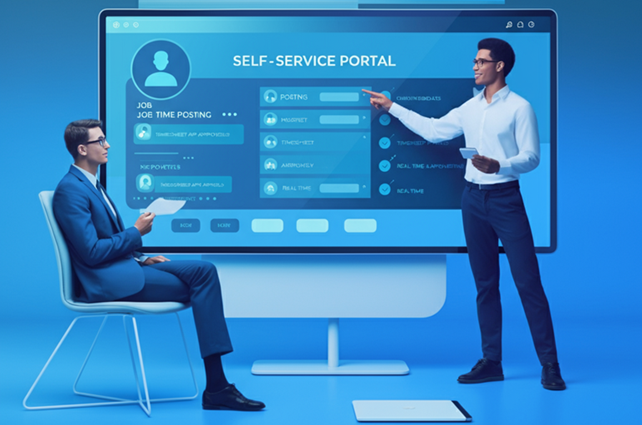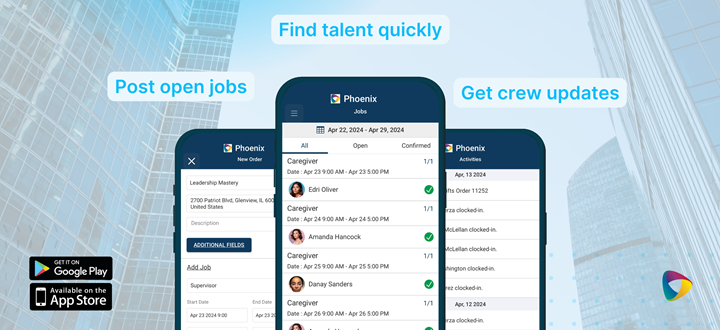
A Staffing Agency's Guide to Pitching Client Self-Service
Running a staffing agency often feels like a constant balancing act. Between sending emails, filling out forms, and chasing approvals, your day can quickly fill with repetitive tasks that slow you down. At first, these workflows might seem manageable, but as the business scales, the never-ending cycle of back-and-forth communication becomes a bottleneck—not only for your team but also for your clients.
As staffing businesses become more technology-powered, it is possible that your current technology offers various ways to streamline the operation and provide self-service for your clients, allowing them to manage jobs and approve timesheets. But wait—it’s not that simple. First, your clients have enough things to worry about, and the biggest challenge is learning something new.
So how do you convince clients to embrace this game-changing tool? Even the most intuitive platforms can face resistance if clients view them as just another complicated software update. To win their trust, first you have to ensure if client self-service makes sense for your agency. The key lies in presenting the portal as an enhancement to their workflow, not an additional hurdle.
Below, we will look at why client self-service portals are valuable. We will also discuss how to present their benefits to your clients. This will help you make the information feel relevant, encouraging, and suited to their needs. Grab your coffee, and let’s dive in.
Table of Contents
- Selling the “Why” to Your Clients
- Benefits For Your Clients
- Benefits For Your Agency
- The Secret to Pitching a Self-Service Portal
- Making Onboarding a Breeze
- Monitoring Progress and Success
- The Future of Staffing, Made Simple
Selling the “why” to your clients
Before you pitch the “how,” start with the “why.” Why should your clients care? Why does it make sense for your agency to introduce this tool?
Self-service portals are about more than just efficiency. They change how your business works. This lets clients manage simple, repetitive tasks. You can then focus on important plans.
Benefits For Your Clients
- Instant Access for Job Posts: Clients can post jobs whenever it’s convenient for them, whether it’s during office hours or after regular business hours. There’s no waiting on emails or callbacks. Automation picks up the task and initiates the hiring pipeline immediately.
- Better Candidate Management: Instead of juggling spreadsheets or emails, clients can easily organize their preferred candidates. For example, they can mark their top choices for upcoming projects or roles, saving time and ensuring continuity.
- Full Transparency: Clients gain real-time insight into what’s happening with their job orders, such as which roles have been filled and the next steps. This transparency builds trust and eliminates confusion.
- Data Accuracy: Clients input their own job details directly into the system. This minimizes mistakes caused by back-and-forth communication or manual data entry.
- Streamlined Timesheet Approvals: Reviewing and approving worker hours becomes seamless, especially with advanced features like geolocation tracking. Plus, clients can provide direct feedback to maintain their team quality.
By lightening the administrative load, clients free up time for their core responsibilities. It’s a solution that benefits them in tangible ways—not just a shiny new tool they’ll find overwhelming.

Benefits For Your Agency
From your perspective, the portal doesn’t just improve efficiency; it creates capacity. The portal handles tedious, routine processes, meaning fewer emails, fewer errors, and more time to grow your business strategically. You get to focus on what matters—building stronger client relationships and ensuring customer satisfaction, both of which drive repeat business.
This isn’t about replacing your people with technology. It’s about letting tech handle the labor intenstive tasks so your team can focus on delivering results your clients notice and appreciate.
The Secret to Pitching a Self-Service Portal
Even though self-service portals bring plenty of value, not all clients will immediately see the benefits. Some might worry it’ll require a steep learning curve. Others may fear it threatens the personal attention they’ve come to expect from your team. By addressing these concerns head-on, you can frame the portal as an ally in their success—not a disruption.
1. Focus on Specific Pain Points
You’ll likely find your clients share one thing in common—pain points. Are they tired of endless follow-ups on job orders? Frustrated by long approval processes or system delays? By showing how the portal directly solves their unique struggles, you can tailor its value to their situations.
For example, you might say:
“We understand how time-consuming it can be to email orders back and forth. With our self-service portal, you can simply post a job in minutes and hit submit. From there, automation jumps in and starts matching you with top candidates immediately. This gives you back hours of time each week.”
This changes the discussion from the tool’s features to the real-world problems it solves. This is what clients care about most.
2. Reassure Clients It’s a Helper, Not a Replacement
Clients might assume that technology means less personal interaction. Be clear that your portal will improve communication and collaboration, while maintaining the personal touch they value.For example:
“The portal gives you control over adding jobs when it’s convenient for you. But if you have questions or need a personal touch, we’re here to help. Think of the portal as an extra convenience—not a replacement for the service you rely on.”
This message reassures clients that making the switch won’t mean losing what they love most about your agency.
3. Use Real-World Examples
Tie features to relatable, everyday uses. Paint a picture of how the portal solves challenges for businesses in different industries. A few examples:
-
Hospitality:
“When Diamond Hotels needed extra banquet servers at the last minute, they used the portal to instantly post the request. The role was filled within hours, with no panicked emails or calls.” -
Healthcare:
“Imagine backfilling a nurse’s shift while cutting the usual approval workflow in half. That’s what our healthcare clients love about the portal.” -
Education:
“Substitute teaching requests no longer take a ton of back-and-forth. Schools using the portal report quicker turnarounds and fewer staffing delays.”
By making the benefits visual and concrete, clients see how the portal fits seamlessly into their unique workflows.
4. Acknowledge Resistance
Adapting to new tools comes with hesitation—it’s natural. Instead of sidestepping this, proactively address it. Highlight the support you’ll provide to make the transition simple and stress-free.
Try saying:
“We know change can feel like extra work at first. That’s why we provide customized walkthroughs, easy-to-follow guides, and live support to make this transition as smooth as possible. Plus, you’re always welcome to stick to the methods you’re comfortable with—we’ll handle your needs how you like.”
Creating an environment where clients feel supported empowers them to give it a try.
5. Showcase Proven Success
Finally, nothing persuades quite like proof. Share case studies, testimonials, or metrics showing how other businesses benefited from using the portal.
For example:
“Our hospitality client, Bliss Events, saved 60% on admin time during their high season. They credited the portal’s efficiency for helping them keep up with demand.”
Making Onboarding a Breeze
Even if you’ve sold the portal’s benefits, adoption depends on how smooth the onboarding process is. A few steps can make a world of difference in helping clients hit the ground running.
-
Step 1: Create simple guides or explainer videos that walk through major tasks like job postings or approvals.
-
Step 2: Host live demonstrations where clients can ask questions and get answers immediately. Personalized attention often removes hesitation.
-
Step 3: Open a dedicated support channel where clients can report issues and get solutions quickly.
-
Step 4: Encourage them to start small. Ask them to test the portal with a low-priority job. Success here builds confidence and trust.
Monitoring Progress and Success
Once clients take off with the portal, it’s important to track how well it’s working—for their sake and yours. Regularly review these key metrics:
-
Adoption Rates:
What percentage of clients are actively using the portal? -
Efficiency Gains:
Is job posting faster? Are administrative workflows smoother? -
Error Reduction:
Are client-generated job postings more accurate? -
Client Feedback:
Are clients reporting greater satisfaction with your services?
Share wins with your clients, no matter how small early on:
“Since implementing the portal, we’ve cut order processing times by 50%. 80% of users report higher satisfaction. This shows how much value the platform is adding.”
The Future of Staffing, Made Simple
The self-service portal is more than a tool; it’s a way to work smarter, not harder. It simplifies workflows, enhances transparency, and empowers your clients while giving your agency room to thrive.
By addressing objections, offering strong onboarding, and providing ongoing support, you guarantee a smooth transition and lasting results for everyone involved.
When the portal becomes part of your operations, your clients will wonder why they didn’t adopt it sooner. Efficiency, accuracy, and peace of mind are just a few clicks away. It’s time to step into the future of staffing—together.


 5.0
5.0